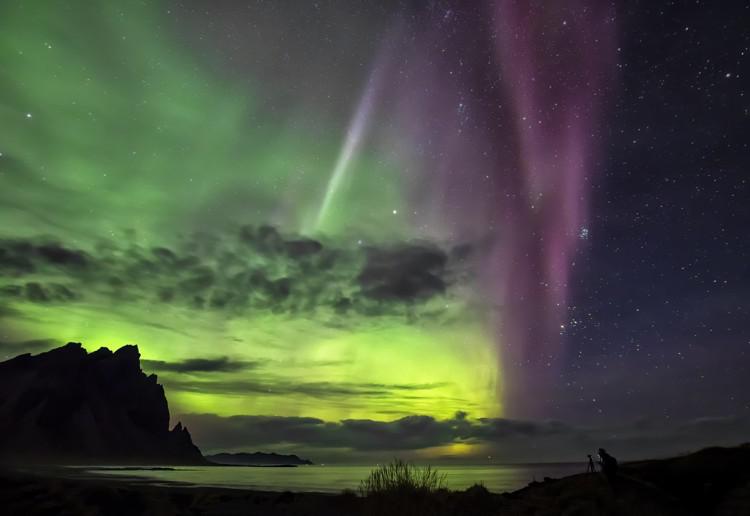This page describes an image Multicolored aurora in Iceland, by Marco Migliardi on behalf of Associazione Astronomica Cortina, Italy
Image caption:
First place in the 2021 IAU OAE Astrophotography Contest, category Aurorae (still images)
Aurorae are the result of ionisation and excitation processes in Earth's upper atmosphere, caused by charged particles from the solar wind or from coronal mass ejections. The different colours in an aurora display indicate the species of atmospheric atoms and molecules involved. The most common colour is a bright green, which, together with deep red, originates from atomic oxygen. Blue, purple and pink hues are much rarer and originate from molecular nitrogen. The reflection of the aurora in the water indicates the brightness of intense aurorae at higher latitudes.
Scroll to captions in other languages
Image credit:
Marco Migliardi on behalf of Associazione Astronomica Cortina/IAU OAE.
DOI: 10.5281/zenodo.5273473
Related glossary terms:
Aurora
, Aurora Borealis
, Geomagnetic Storm
, Ionization
Categories:
Naked Eye Astronomy
Image license: Creative Commons Attribution 4.0 International (CC BY 4.0) Creative Commons Attribution 4.0 International (CC BY 4.0) icons
The media file captions presented on the OAE website were written, translated and reviewed by a collective effort from the OAE, the OAE Centers and Nodes, the OAE National Astronomy Education Coordinators (NAECs) and other volunteers. You can find a full list of credits for our translation project here. All media file captions are released under a Creative Commons CC BY-4.0 license and should be credited to "IAU OAE". The media files themselves may have different licenses (see above) and should be credited as listed above under "credit".
If you notice a factual error in this caption or an error in any of its translations then please get in touch.
Captions in Different Languages:
Image caption: ২০২১ এইএইউ ওএই অ্যাস্ট্রোফটোগ্রাফি প্রতিযোগিতায় প্রথম স্থান, বিভাগ অরোরা (এখনও ছবি)
অরোরা হল পৃথিবীর উপরের বায়ুমণ্ডলে আয়নিকরণ এবং উত্তেজনা প্রক্রিয়ার ফলাফল, যা সৌর বায়ু থেকে আধানযুক্ত কণা বা করোনাল ভর নির্গমন থেকে সৃষ্ট। একটি অরোরা ডিসপ্লেতে বিভিন্ন রং বায়ুমণ্ডলীয় পরমাণু এবং জড়িত অণুগুলির প্রজাতি নির্দেশ করে। সবচেয়ে সাধারণ রঙ একটি উজ্জ্বল সবুজ, যা গভীর লালের সাথে একত্রে পারমাণবিক অক্সিজেন থেকে উদ্ভূত হয়। নীল, বেগুনি এবং গোলাপী রঙগুলি অনেক বিরল এবং আণবিক নাইট্রোজেন থেকে উদ্ভূত। জলে অরোরার প্রতিফলন উচ্চ অক্ষাংশে তীব্র অরোরার উজ্জ্বলতা নির্দেশ করে।
Image credit: অ্যাসোসিয়াজিওন অ্যাস্ট্রোনোমিকা কর্টিন/এইএইউ ওএই-এর পক্ষ থেকে মার্কো মিগলিয়ার্দি।
Related glossary terms: Aurora , Aurora Borealis , Geomagnetic Storm , Ionization Caption translation status: Not yet approved by a reviewer
Caption translators: Raktim Mukherjee
Image caption: Première place au concours d'astrophotographie 2021 de l'IAU OAE, catégorie Aurores (images fixes)
Les aurores sont le résultat de processus d'ionisation et d'excitation dans la haute atmosphère terrestre, causés par des particules chargées provenant du vent solaire ou d'éjections de masse coronale. Les différentes couleurs d'une aurore indiquent les espèces d'atomes et de molécules atmosphériques impliquées. La couleur la plus courante est le vert vif, qui, avec le rouge profond, provient de l'oxygène atomique. Les teintes bleues, violettes et roses sont beaucoup plus rares et proviennent de l'azote moléculaire. La réflexion de l'aurore dans l'eau indique la luminosité des aurores intenses à des latitudes plus élevées.
Image credit: Marco Migliardi au nom de l'Associazione Astronomica Cortina/IAU OAE.
Related glossary terms: Aurore , Aurore boréale , Ionisation , Tempête géomagnétique Caption translation status: Not yet approved by a reviewer
Caption translators: Emmanuel Rollinde
Image caption: Primo posto al concorso di astrofotografia IAU OAE 2021, categoria Aurorae (immagini fisse)
Le aurore sono il risultato di processi di ionizzazione ed eccitazione nell'alta atmosfera terrestre, causati da particelle cariche provenienti dal vento solare o da espulsioni di massa coronale. I diversi colori di un'aurora indicano le specie di atomi e molecole atmosferiche coinvolte. Il colore più comune è il verde brillante che, insieme al rosso intenso, deriva dall'ossigeno atomico. Le tonalità blu, viola e rosa sono molto più rare e provengono dall'azoto molecolare. Il riflesso dell'aurora nell'acqua indica la luminosità delle aurore intense alle latitudini più elevate.
Image credit: Marco Migliardi on behalf of Associazione Astronomica Cortina/IAU OAE.
Related glossary terms: Aurora , Aurora Boreale , Ionizzazione , Tempesta Geomagnetica Caption translation status: Approved by a reviewer
Caption translators: Giuliana Giobbi, Valentina La Parola
Caption reviewers: Rosa Valiante, Rodolfo Canestrari
Image caption: 2021年国际天文学联合会(IAU)OAE天文摄影比赛极光类别(静态图像)一等奖。
极光是地球高层大气电离和激发过程的结果,由太阳风或日冕物质抛射产生的带电粒子引起。极光中不同的颜色显示了参与反应的大气原子和分子的种类。最常见的颜色是明亮的绿色,它与深红色一起源自原子氧。蓝色、紫色和粉色的色调则较为罕见,来源于分子氮。极光在水中的倒影显示了高纬度地区强烈极光的亮度。
Image credit: 马尔科·米利亚尔迪代表科尔蒂纳天文协会/IAU OAE。
Related glossary terms: 北极光 , 地磁暴 , 极光 , 电离 Caption translation status: Not yet approved by a reviewer
Caption translators: Xiao Jingyu
Image caption: 2021年國際天文學聯合會(IAU)OAE天文攝影比賽極光類別(靜態圖像)一等獎。
極光是地球高層大氣電離和激發過程的結果,由太陽風或日冕物質拋射產生的帶電粒子引起。極光中不同的顏色顯示了參與反應的大氣原子和分子的種類。最常見的顏色是明亮的綠色,它與深紅色一起源自原子氧。藍色、紫色和粉色的色調則較為罕見,來源於分子氮。極光在水中的倒影顯示瞭高緯度地區強烈極光的亮度。
Image credit: 馬爾科·米利亞爾迪代表科爾蒂納天文協會/IAU OAE。
Related glossary terms: 北極光 , 地磁暴 , 極光 , 電離 Caption translation status: Not yet approved by a reviewer
Caption translators: An automated transliteration from the simplified Chinese translation by - Xiao Jingyu









